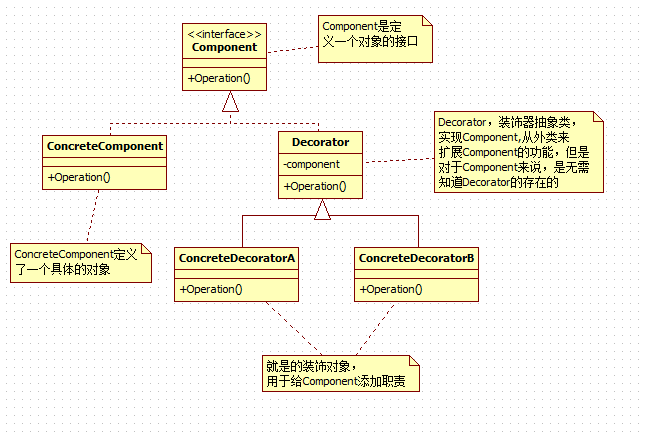
一. 概述
装饰器模式(Decorator),动态地给一个对象添加一些额外的职责,就增加功能来说,装饰器模式比生成子类更为灵活;它允许向一个现有的对象添加新的功能,同时又不改变其结构。
装饰器模式属于结构型模式。
二. UML类图解析
装饰器模式的UML类图如下:

- Component:接口,定义一个抽象接口,真实对象和装饰对象具有相同的接口,以便动态的添加职责。
- ConcreteComponent:具体的对象。
- Decorator:装饰类,继承了Component,从外类来扩展Component类的功能,并且持有一个构建引用,进行请求转发。
- ConcreteDecorator:具体装饰类,用于给实际对象添加职责。
三. 代码实现
现在考虑这样一个场景,现在有一个煎饼摊,人们去买煎饼(Pancake),有些人要加火腿(Ham)的,有些人要加鸡蛋(Egg)的,有些人要加生菜(Lettuce)的,当然土豪可能有啥全给加上^_^。用上述的装饰器模式来进行编码。
1. 定义煎饼接口IPancake
1 | package io.github.brightloong.design.decorator; |
2. 定义具体的煎饼Pancake
1 | package io.github.brightloong.design.decorator; |
3. 定义抽象装饰类PancakeDecorator
1 | package io.github.brightloong.design.decorator; |
4. 具体装饰类EggDecorator
1 | package io.github.brightloong.design.decorator; |
5. 具体装饰类HamDecorator
1 | package io.github.brightloong.design.decorator; |
6. 具体装饰类LettuceDecorator
1 | package io.github.brightloong.design.decorator; |
7. 客户端调用以及结果
1 | package io.github.brightloong.design.decorator; |
输出结果
1 | =========我是土豪都给我加上=========== |
四. 总结
关于装饰器模式的使用,在我看来主要有一下几点需要注意的
- 抽象装饰器和具体被装饰的对象实现同一个接口
- 抽象装饰器里面要持有接口对象,以便请求传递
- 具体装饰器覆盖抽象装饰器方法并用super进行调用,传递请求
1. 适用场景
- 扩展一个类的功能。
- 动态添加功能,动态撤销。
2. 优点
- 装饰类和被装饰类都只关心自身的核心业务,实现了解耦。
- 方便动态的扩展功能,且提供了比继承更多的灵活性。
3. 缺点
- 如果功能扩展过多,势必产生大量的类。
- 多层装饰比较复杂。

